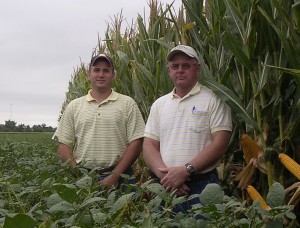Cox Valley View Farms, Long Island, KS – Drip Farm Irrigation Systems on Corn and Soybeans

Even before the perfect storm of diminished water supplies, rising corn prices and government cost-share funding hit the plains, Steven Cox knew his irrigated farms would have to change. That’s why he installed his first subsurface drip farm irrigation system over nine years ago on his 4,000 acre operation, and has installed an additional 120 acres of drip irrigation since.
The conversion has allowed him to stretch limited water supplies while increasing yields and gain quality at the same time. “Before drip, we were trying to flood irrigate 60 acres with a 250 GPM well. We were lucky to get top yields on 25 percent of the field. I now get top yields on 100 percent of the field because of the increased uniformity and efficiency I get with drip.”
The following charts show the yield improvements Cox experienced by converting to drip irrigation from gravity irrigation:
Besides higher yields, some of the other benefits of drip irrigation on corn and soybeans include:
- More efficient use of limited water supplies
- Better grain quality
- Lower labor costs
- More precise application of fertilizers
- low operating pressure
- EQIP cost share funding opportunities
- Quick payback
Click here to learn more about Cox Valley View Farms and drip irrigation on corn and soybeans. For Spanish, click here.

I AM IN THE PROCESS OF STARTING A CORN FARM IN CAMEROON, WEST AFRICA. THE SDI TYPE OF FARMING SEEMS REALLY PERFECT FOR THIS TYPE OF VENTURE. ARE THE EQUIPMENT EXPENSIVE TO BUY? I’M NOT A VERY HANDY PERSON, HOW CAN I INSTALL THE EQUIPMENT IN CAMEROON. WOULD I NEED A TECHNICIAN TO ASSIST IN THE EQUIPMENT INSTALLATION?
Hi, Lawrence – I have forwarded your request to the drip expert responsible for your region. You will be contacted shortly. Thanks.